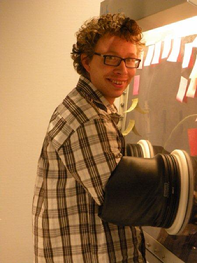Understanding microstructural evolution in mixed metal-oxide silsesquioxane glasses through wet-chemical synthesis
Promotion date: March 28.
Promotor: Prof.dr.ir. André ten Elshof
| Theoretical aspects of Small Angle X-Ray Scattering (SAXS) were evaluated. Rapid in-situ SAXS measurements were performed to measure early-stage agglomeration processes under niobium ethoxide mixtures in the presence and absence of 1,2-bis-(triethoxysilyl)-ehtane (BTESE). Also in-situ SAXS measurements were evaluated while drying mixed niobium ethoxide bridged silsesquioxane sol. Different synthesis routes were evaluated with the aim to optimize the incorporation of niobium within a hybrid silica matrix on an atomic scale. In the last chapter a different approach was applied to the dispersion of metal ions within the silsesquioxane matrix: with the aim to synthesize single source precursors, a malonamide bridged silsesquioxane was synthesized. |
Was your research application driven?
Selective membrane layers of condensed silsesquioxanes may be altered by incorporating metal oxides within the matrix. Doping and mixing techniques could improve the chemical quality and stability of the membranes and its selectivity performances, by improving the diffusion processes taking place at the contact areas of the membranes. However, these chemical processes and techniques are difficult to control. Making use of flexible polymers still has disadvantages for gas separation membranes that have to function and perform well under high pressure conditions.
The approach in the first chapters is quite theoretical in nature, studying the agglomeration processes as well as the drying processes. The last chapter is more application oriented, developing/designing active silica-groups that act as a kind of precursor for the metal-oxides. Together with the Inorganic Membrane Group we actually tested these membranes.
Can you recall some special moments during your PhD period that were of importance for the progress of your work?
The first moment I recall was the insight I got, that impurities in these specific membranes could account for structure problems undermining the selectivity performances. By using SAXS measurements, I was able to see what actually happened in the first stages of building these membranes. Characterizing the agglomeration processes was an important stage of the project.
One could say that I started this project with an engineering approach, but gradually extra fundamental issues appeared. Being an experimentalist, this procedure of working enriched my abilities as a scientist. Especially in the experimental sessions in Grenoble, I performed the specialized X-Ray measurements from a profound theoretical basic approach. This really led to nice results and understanding of the phenomena involved. This work also contributed chapter in a book: “The Sol-Gel Handbook”, Chapter: Time-resolved Small angle X-ray scattering: Paragraph 2: Theory of SAXS.
Did you publish some nice articles?
Articles appeared in Journal of Physical Chemistry C, Journal of Colloid and Interface Science, Journal of Sol-Gel Science and Technology. Two chapters are almost ready to be published. They will be submitted in the next month to Journal of Materials Chemistry and Journal of Colloid and Interface Science. For another chapter, I did some additional measurements. This will take me a little more time to publish and will be send to a crystallographic journal.
What are your future plans?
Right now I am writing a proposal in order to get a grant for researching volatile mixed metal oxide precursors (mixed metal alkoxides). Such precursors can be used for chemical vapor deposition (CVD) of complex metal oxides. CVD offers a controlled buildup of atomic layers and such materials can be synthesized at much lower temperatures T<400°C as compared to conventional solid state chemistry (T>1000°C).
Here, I will particularly focus on precursors that contain lanthanides, which are a particular group of metals with strong luminescent (light emitting) properties. Such materials can be used in screens, YAG-lasers, energy efficient light bulbs and biological sensors. The key challenge of the project is to incorporate a mixture of different metals in a single precursor/molecule, while keeping such precursors/molecules small and volatile.
In the PhD project I learned to really appreciate the team atmosphere in research. This I hope to find in my new job as well. Scientific research, and success, is based on both showing personal initiative and being open, trusting collaboration with your colleagues.
All research is multidisciplinary, in my opinion, and I hope to find that in my future job as well. Though within Mesa+ my work was quite chemical in nature, I was collaborating with other groups and learned to work with up-to-date experimental equipment such as SEM and TEM microscopy.
By the way: a good new TEM would be a good investment, in my opinion, for Mesa+, making it possible to work under low voltage conditions with more ‘problematic’ samples. In my research I encountered some limitations, especially while performing Energy Electron Loss Spectroscopy. Investing in this generation of equipment would allow Mesa+ to follow a new revolutionary trend, focusing on Liquid-cell TEM.

